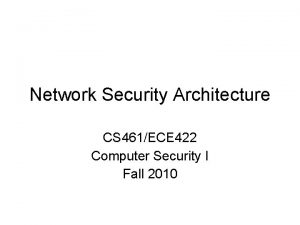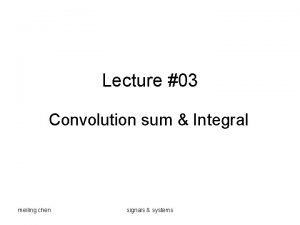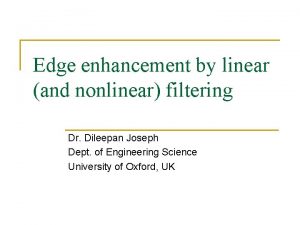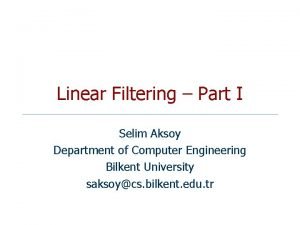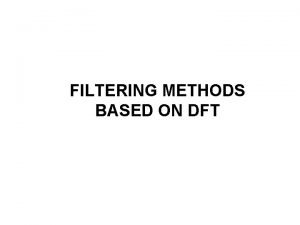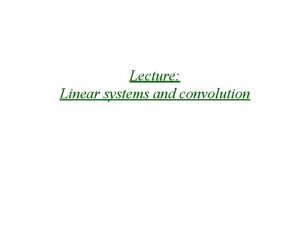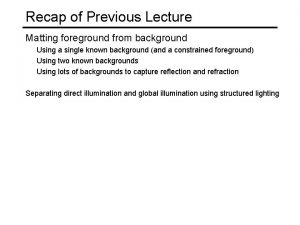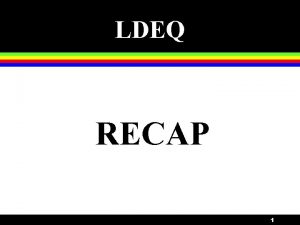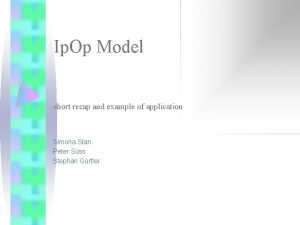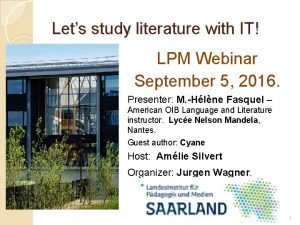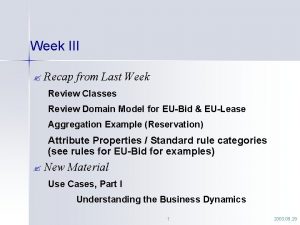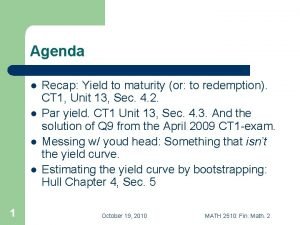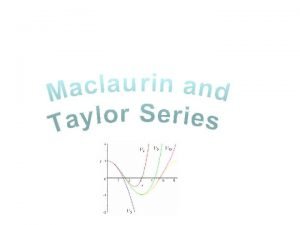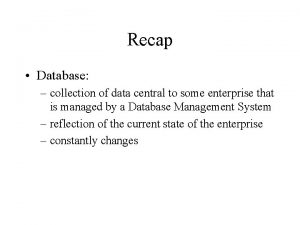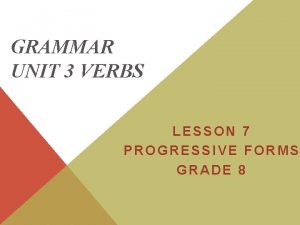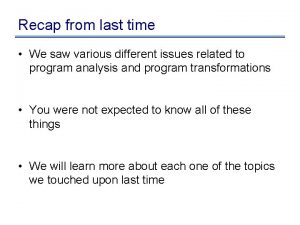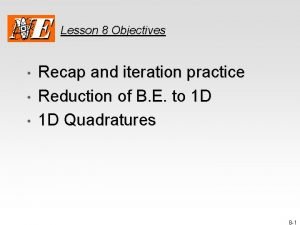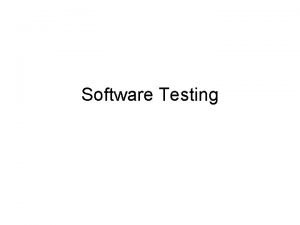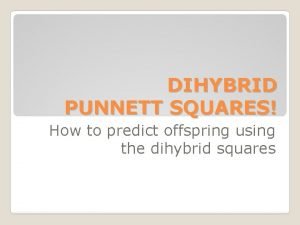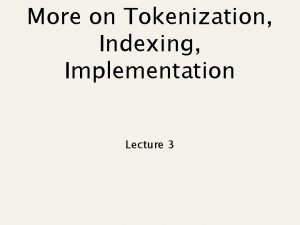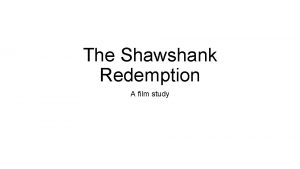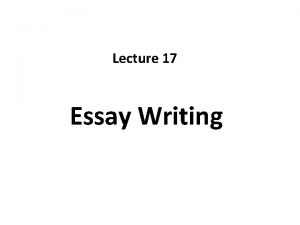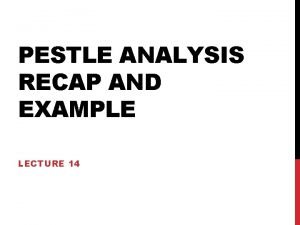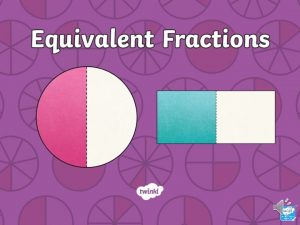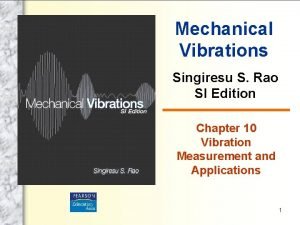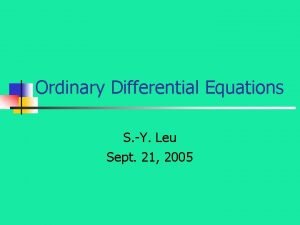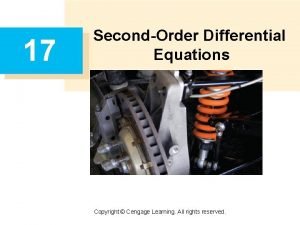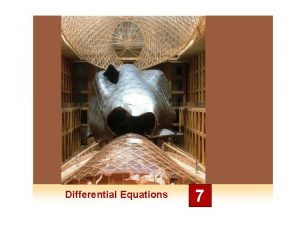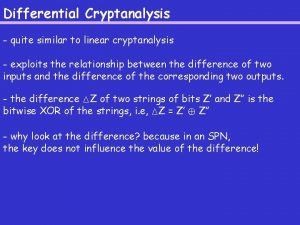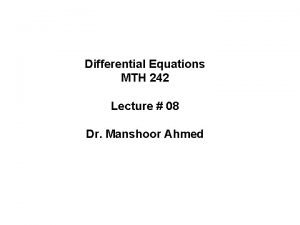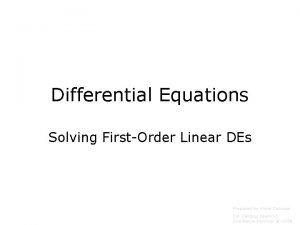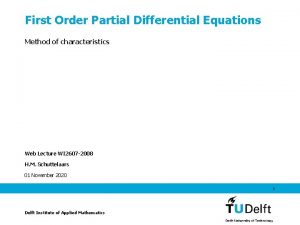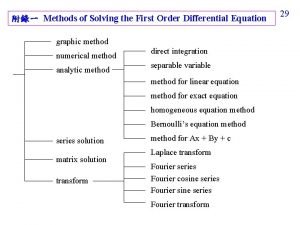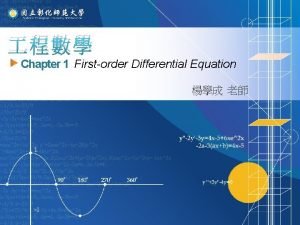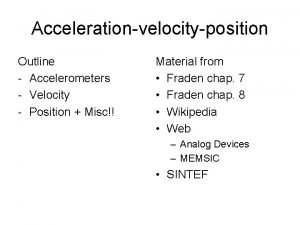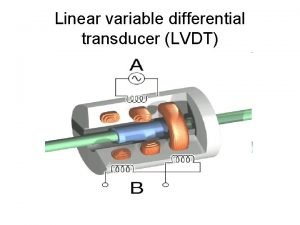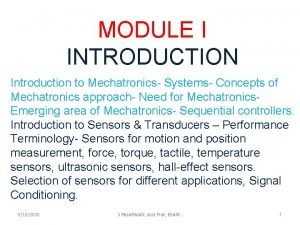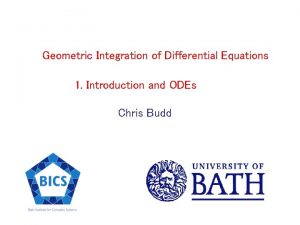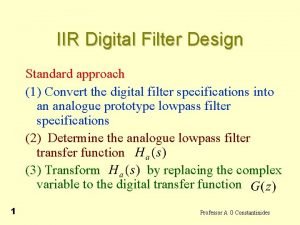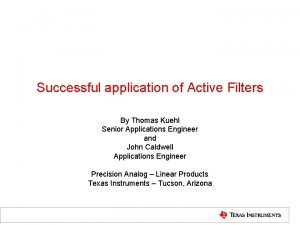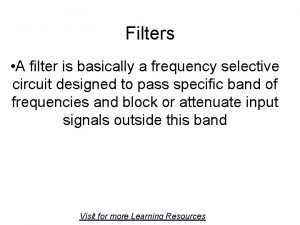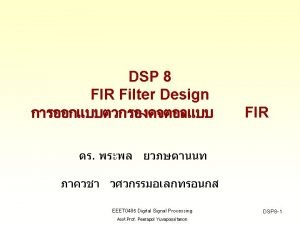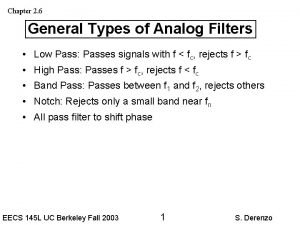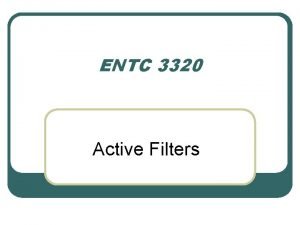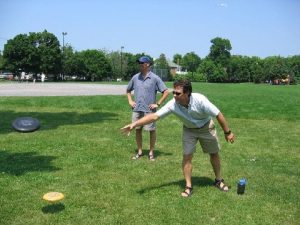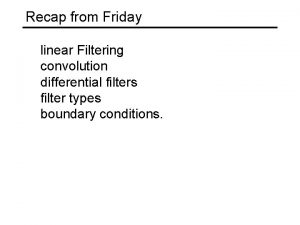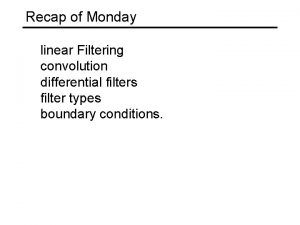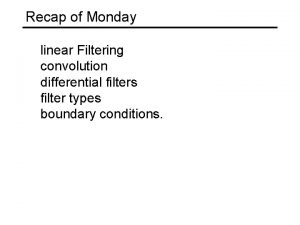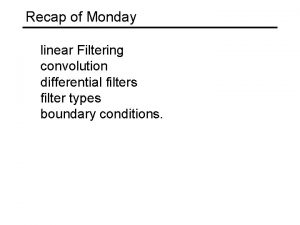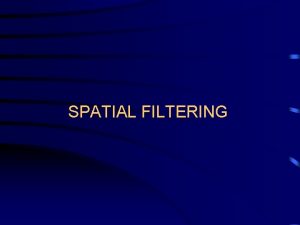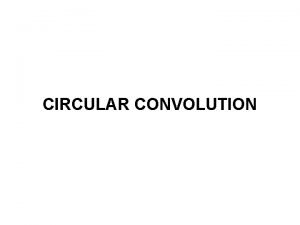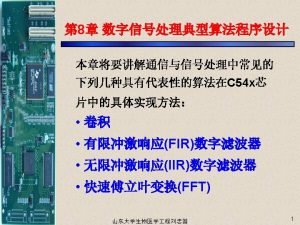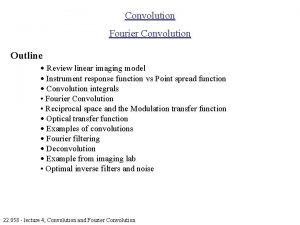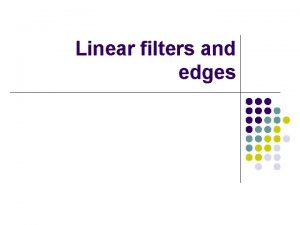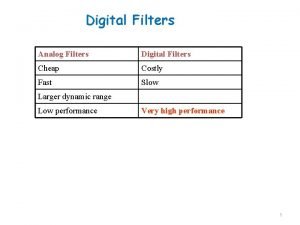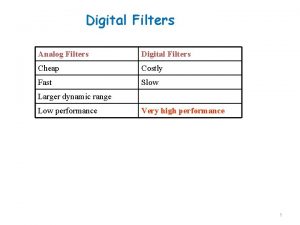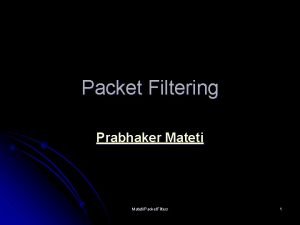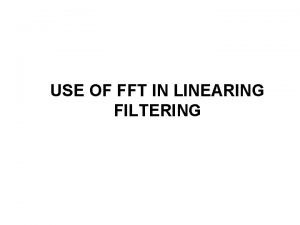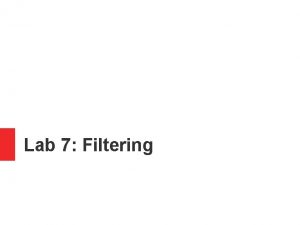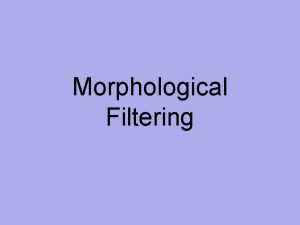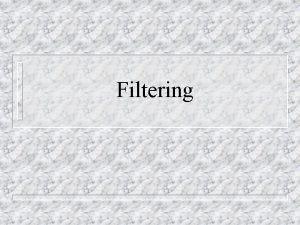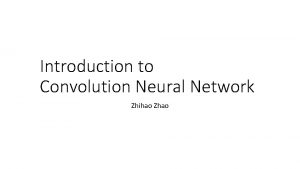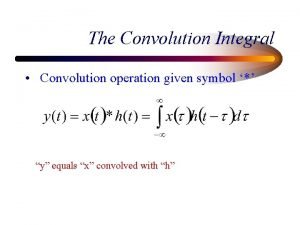Recap from Friday linear Filtering convolution differential filters



































































- Slides: 67

Recap from Friday linear Filtering convolution differential filters filter types boundary conditions.

The Frequency Domain Somewhere in Cinque Terre, May 2005 Slides from Steve Seitz and Alexei Efros CS 195 g: Computational Photography James Hays, Brown, Spring 2010

Salvador Dali “Gala Contemplating the Mediterranean Sea, which at 30 meters becomes the portrait of Abraham Lincoln”, 1976



A nice set of basis Teases away fast vs. slow changes in the image. This change of basis has a special name…

Jean Baptiste Joseph Fourier (1768 -1830) had crazy idea (1807): Any periodic function can be rewritten as a weighted sum of sines and cosines of different frequencies. Don’t believe it? • Neither did Lagrange, Laplace, Poisson and other big wigs • Not translated into English until 1878! But it’s true! • called Fourier Series

A sum of sines Our building block: Add enough of them to get any signal f(x) you want! How many degrees of freedom? What does each control? Which one encodes the coarse vs. fine structure of the signal?

Fourier Transform We want to understand the frequency w of our signal. So, let’s reparametrize the signal by w instead of x: f(x) Fourier Transform F(w) For every w from 0 to inf, F(w) holds the amplitude A and phase f of the corresponding sine • How can F hold both? Complex number trick! We can always go back: F(w) Inverse Fourier Transform f(x)

Time and Frequency example : g(t) = sin(2 pf t) + (1/3)sin(2 p(3 f) t)

Time and Frequency example : g(t) = sin(2 pf t) + (1/3)sin(2 p(3 f) t) = +

Frequency Spectra example : g(t) = sin(2 pf t) + (1/3)sin(2 p(3 f) t) = +

Frequency Spectra Usually, frequency is more interesting than the phase

Frequency Spectra = = +

Frequency Spectra = = +

Frequency Spectra = = +

Frequency Spectra = = +

Frequency Spectra = = +

Frequency Spectra =

Frequency Spectra

Extension to 2 D in Matlab, check out: imagesc(log(abs(fftshift(fft 2(im)))));

Man-made Scene

Can change spectrum, then reconstruct

Low and High Pass filtering

The Convolution Theorem The greatest thing since sliced (banana) bread! • The Fourier transform of the convolution of two functions is the product of their Fourier transforms • The inverse Fourier transform of the product of two Fourier transforms is the convolution of the two inverse Fourier transforms • Convolution in spatial domain is equivalent to multiplication in frequency domain!

2 D convolution theorem example |F(sx, sy)| f(x, y) * h(x, y) |H(sx, sy)| g(x, y) |G(sx, sy)|

Fourier Transform pairs

Low-pass, Band-pass, High-pass filters low-pass: High-pass / band-pass:

Edges in images

What does blurring take away? original

What does blurring take away? smoothed (5 x 5 Gaussian)

High-Pass filter smoothed – original

Band-pass filtering Gaussian Pyramid (low-pass images) Laplacian Pyramid (subband images) Created from Gaussian pyramid by subtraction

Laplacian Pyramid Need this! Original image How can we reconstruct (collapse) this pyramid into the original image?

Why Laplacian? Gaussian delta function Laplacian of Gaussian

Unsharp Masking - +a = =

Image gradient The gradient of an image: The gradient points in the direction of most rapid change in intensity The gradient direction is given by: • how does this relate to the direction of the edge? The edge strength is given by the gradient magnitude

Effects of noise Consider a single row or column of the image • Plotting intensity as a function of position gives a signal How to compute a derivative? Where is the edge?

Solution: smooth first Where is the edge? Look for peaks in

Derivative theorem of convolution This saves us one operation:

Laplacian of Gaussian Consider Laplacian of Gaussian operator Where is the edge? Zero-crossings of bottom graph

2 D edge detection filters Laplacian of Gaussian derivative of Gaussian is the Laplacian operator:

Try this in MATLAB g = fspecial('gaussian', 15, 2); imagesc(g); colormap(gray); surfl(g) gclown = conv 2(clown, g, 'same'); imagesc(conv 2(clown, [-1 1], 'same')); imagesc(conv 2(gclown, [-1 1], 'same')); dx = conv 2(g, [-1 1], 'same'); imagesc(conv 2(clown, dx, 'same')); lg = fspecial('log', 15, 2); lclown = conv 2(clown, lg, 'same'); imagesc(lclown) imagesc(clown +. 2*lclown)

Campbell-Robson contrast sensitivity curve

Depends on Color R G B

Lossy Image Compression (JPEG) Block-based Discrete Cosine Transform (DCT)

Using DCT in JPEG The first coefficient B(0, 0) is the DC component, the average intensity The top-left coeffs represent low frequencies, the bottom right – high frequencies

Image compression using DCT enables image compression by concentrating most image information in the low frequencies Lose unimportant image info (high frequencies) by cutting B(u, v) at bottom right The decoder computes the inverse DCT – IDCT • Quantization Table 3 5 7 9 11 13 15 17 19 21 23 11 13 15 17 19 21 23 25 27 29 31

Block size in JPEG Block size • small block – faster – correlation exists between neighboring pixels • large block – better compression in smooth regions • It’s 8 x 8 in standard JPEG

JPEG compression comparison 89 k 12 k

Morphological Operation What if your images are binary masks? Binary image processing is a well-studied field, based on set theory, called Mathematical Morphology

Preliminaries

Preliminaries

Preliminaries

Basic Concepts in Set Theory A is a set in , a=(a 1, a 2) an element of A, a A If not, then a A : null (empty) set Typical set specification: C={w|w=-d, for d D} A subset of B: A B Union of A and B: C=A B Intersection of A and B: D=A B Disjoint sets: A B= Complement of A: Difference of A and B: A-B={w|w A, w B}=

Preliminaries

Dilation and Erosion Two basic operations: • A is the image, B is the “structural element”, a mask akin to a kernel in convolution Dilation : (all shifts of B that have a non-empty overlap with A) Erosion : (all shifts of B that are fully contained within A)

Dilation

Dilation

Erosion

Erosion Original image Eroded image

Erosion Eroded once Eroded twice

Opening and Closing Opening : smoothes the contour of an object, breaks narrow isthmuses, and eliminates thin protrusions Closing : smooth sections of contours but, as opposed to opning, it generally fuses narrow breaks and long thin gulfs, eliminates small holes, and fills gaps in the contour Prove to yourself that they are not the same thing. Play around with bwmorph in Matlab.

Opening and Closing OPENING: The original image eroded twice and dilated twice (opened). Most noise is removed CLOSING: The original image dilated and then eroded. Most holes are filled.

Opening and Closing

Boundary Extraction

Boundary Extraction
 Ingress filtering vs egress filtering
Ingress filtering vs egress filtering Integral
Integral Difference between linear and nonlinear spatial filters
Difference between linear and nonlinear spatial filters Linear filtering
Linear filtering Linear filtering
Linear filtering Different filtering methods based on dft
Different filtering methods based on dft Linear filtering in image processing
Linear filtering in image processing Convolution linearity
Convolution linearity Recap background
Recap background Let's have a quick recap
Let's have a quick recap The great gatsby chapter 8
The great gatsby chapter 8 Ldeq recap
Ldeq recap Logbook recap example
Logbook recap example 60 minutes recap
60 minutes recap Let's recap
Let's recap Recap
Recap Recap from last week
Recap from last week Briefly recap
Briefly recap Pee paragraph romeo and juliet
Pee paragraph romeo and juliet Recap poster
Recap poster Price is right recap
Price is right recap Ytm recap
Ytm recap Differentiation recap
Differentiation recap Recap database
Recap database Perfect lesson 7
Perfect lesson 7 Horizontal axis on the coordinate plane
Horizontal axis on the coordinate plane The crucible act 1 questions
The crucible act 1 questions Saw recap
Saw recap What is the purpose of an iteration recap
What is the purpose of an iteration recap Recap accounting
Recap accounting Black box recap
Black box recap Introduction for recap
Introduction for recap How to foil genotypes
How to foil genotypes Recap indexing scans
Recap indexing scans Summary of shawshank redemption
Summary of shawshank redemption What is an essay
What is an essay The crucible act 1 recap
The crucible act 1 recap Briefly recap
Briefly recap Recap intensity clipping
Recap intensity clipping Example of recap
Example of recap Fractions recap
Fractions recap Recap introduction
Recap introduction Fullarton tachometer
Fullarton tachometer Ordinary differential equations
Ordinary differential equations Homogeneous 2nd order differential equation
Homogeneous 2nd order differential equation Logistic differential equation
Logistic differential equation Differentiate between linear and differential cryptanalysis
Differentiate between linear and differential cryptanalysis Higher order linear differential equations
Higher order linear differential equations Integrating factor method
Integrating factor method Characteristic equation
Characteristic equation First-order linear equations
First-order linear equations Orthogonal trajectories
Orthogonal trajectories Linear variable differential transformer
Linear variable differential transformer Linear variable differential transducer
Linear variable differential transducer Ode
Ode Linear variable differential transformer
Linear variable differential transformer Linear differential equation
Linear differential equation Symplectic
Symplectic Spectral transformation of iir filters
Spectral transformation of iir filters Hailstop hail guard netting
Hailstop hail guard netting Applications of active filters
Applications of active filters Filters in weka
Filters in weka Perceptual filters
Perceptual filters Filter is basically selective circuit
Filter is basically selective circuit High pass and low pass filters
High pass and low pass filters Types of analog filters
Types of analog filters Asp.net mvc 5 identity authentication and authorization
Asp.net mvc 5 identity authentication and authorization Advantage of active filter
Advantage of active filter
